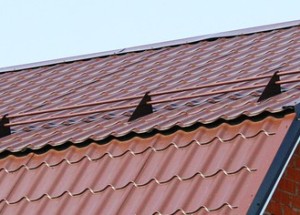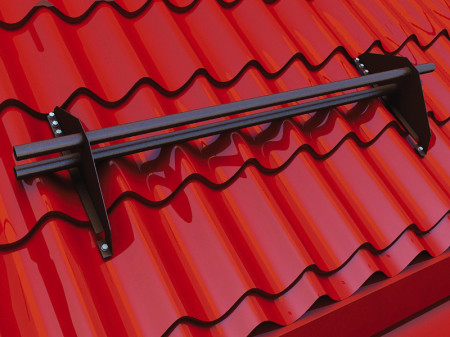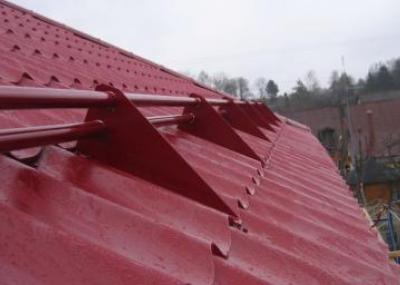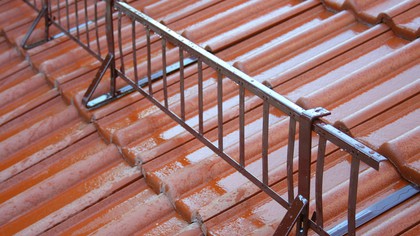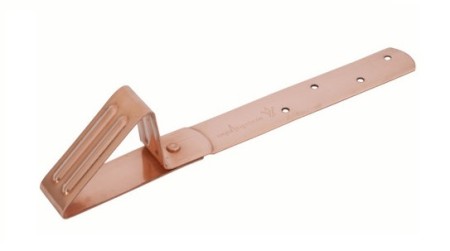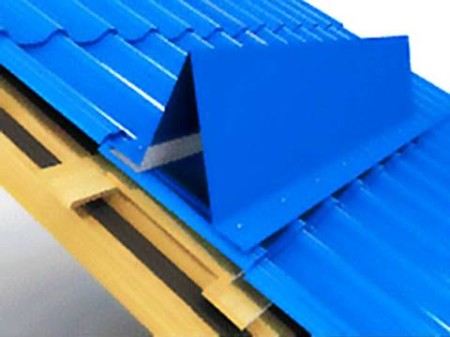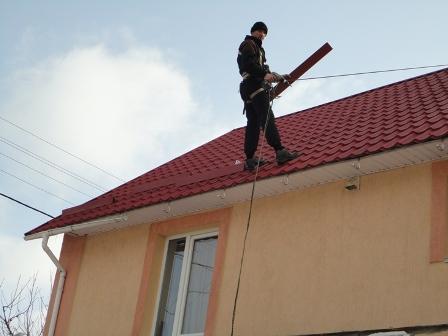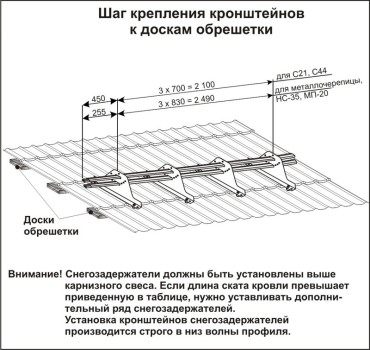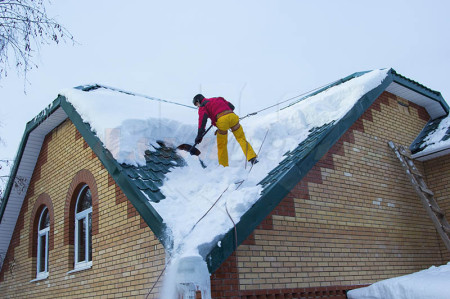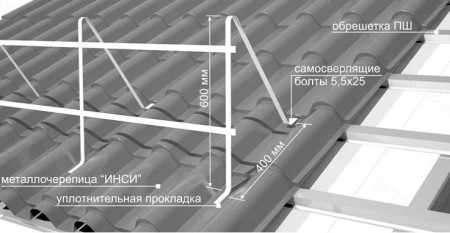Snow, which calmly and evenly lies on the roof, eventually begins to melt from the internal heat of the roof and under the influence of sunlight, and then turns into ice. The sudden descent of the snow-ice mass from the roof represents a real threat to health and even life for the people below. To prevent the snow and ice mass from leaving the roof, elements are installed on the roof, which are called snow holders. In this article we will consider a few questions: what is the snow-holder, what are its functions, the types of snow-holders, the installation of snow-holders, and the possibility of making snow-holders themselves.
Content
Why do you set snow holders?
It should be noted that the purpose of this element is not limited only to ensuring the safety of people. Snow holder significantly reduces the likelihood of damage to the roofing, the occurrence of scratches, cracks, dents, etc.
The presence of a snow-holder on the roof is so important that in many European countries insurance companies refuse to homeowners in the design of insurance, if the roof is missing these elements.
Especially important snow covers for roofs covered with metal roofing material: metal, metal, roofing tin, etc. This is an integral element for multi-level roofs, and installation of a snow-holder under the roof windows is considered mandatory.
In the central zone of Russia, under every meter of the snow-holder, which is installed about five meters from the ridge, it can accumulate up to a ton of snow and ice.
Snow-holders also perform other functions: prevent damage to the drainage system and roof elements - the roof is not deformed due to the weight of the snow, I will not leak ceilings, plantations near the house will not suffer, the same applies to parked cars. In addition, with rapid warming, water flows will not damage the walls of the house.
To ensure proper safety when installing snegozaderzhateley, it is necessary to use safety devices. To clean the roof surface from excess snow, special staircases are installed on its surface.
If the building is more than six meters high, it makes sense to install a protection device in the form of a fence of reinforcement around the perimeter of the roof.
https://www.youtube.com/watch?v=jZ4UMCahtRI
Types of snow chains
There are several types of snow holders. Several models are universal, and are installed on any type of roof. There are models designed only for a certain type of roofing material.
Snow traps are:
- Angular.
- Tubular.
- Latticed.
- Plate.
- Pointed.
- Hook-shaped.
Choosing a particular model, you need to be guided by the following factors: the type of roofing, the type of roof, as well as the peculiarities of weather conditions in your area.
tubular and latticed snow chains
These two types of snegozaderzhateley completely universal. They are installed on roofs covered with sheet, roll roofing materials, and also used as snow holders for shingles. These are sufficiently reliable products, they are installed even on roofs with a large angle of slope of the skates.
If the angle of inclination of the roof slopes is more than 60 degrees, there is no need to install snegozaderzhateli, as on such a steep roof the snow will not be delayed. To the so-called "risk group" are, in the first place, roofs with a small angle of slope of skates - 25-35 degrees.
On such roofs a large snow mass is accumulated and the probability of its sudden descent is high. On such a roof, the snow-holder tubular will be under a large static load, and when the snow falls, dynamic load is added to it. Latticed and tubular snegozaderzhateli quite cope even with a very heavy snow cover.
One of the main advantages of these types of structures is the possibility of mounting on finished roofs, which are in use, and not just new ones, since the brackets of the snow holder are attached to the crate directly through the roofing. Brackets can have a length of 30 cm to 1.5 meters. The length depends on the type of roof construction.
Tubular snow holders extend to the required size by joining the pipes of the structure. Lattice elements are lengthened by adding additional sections.
hook-snowshoes
This type of snegozaderzhateley used on the roofs of european and roofing felt. They are installed only at the stage of installation of roofing or in case of major repairs of the roof. This type of snow-holder is used on roofs with a slope angle of less than 30 degrees. Hooks are installed on the entire surface of the roof in a staggered manner, usually in several rows.
Mount them in the process of laying the roof, attaching them to the beams of the crate. Snow holders should have at least two points of support on the supporting structure. If the budget does not allow, it is possible to install hooks not over the entire roof area, but only at the most dangerous points, for example, above the entrance door, the pedestrian path, above the parking lot of cars, etc.
angle and plate snow chains
Snow plate holder in the form of a plate (angled is its variety) is well suited for mounting on a metal roofing material.
This can be metal, metal profiles, or roofing galvanized sheet metal. These snow holders on the roof are made of the same material as the roof. They are installed as a new roof, and on already in use. A significant disadvantage of these models is an insufficient margin of safety. They will not be able to contain a large mass of snow, so the installation of lamellar and angular snow-holders on the roof with a slope angle of less than 30 degrees does not make sense.
It should be noted that installing snegozaderzhateley does not mean that snow from the roof does not need to be removed. The roof of the snow should be cleaned regularly. If this is not done, then snow can accumulate so much that it will damage both the roof and the snow holders themselves.
snow retardation on the soft roof
Soft roofs have their own design features, which assume special rules for installing snegozaderzhateley. So, according to generally accepted building codes, the maximum angle of the ramp for a soft roof should not exceed 15 degrees. Thus, the roof is almost flat, and there is practically no danger of the large masses of snow and ice coming down. Therefore, for these types of roofs you can use not too strong models snegozaderzhateley. Another feature of the soft roof is a rough surface, since the roofing material has a coating of shallow basalt chips. Because of this, snow can not move freely on the surface of the roof. Another feature of the installation snegozaderzhateley on the soft roof - no need to change the design of the crate, because in this case it is a solid foundation. This fact simplifies and simplifies the installation process.
Installation of snow chains
Installation of these elements is best done in the process of installing the roofing. But if for some reason it was not possible to do so, installation of snow covers can be made after, on the already laid roofing material.
Installation starts from the bottom, from the cornice edge, observing the spacing from the roof edge of approximately 50 centimeters. The method of mounting snow covers is directly dependent on their type. Tubular snow holders are installed in one line. Point and corner - in checkerboard order. If in your region there is a high intensity of precipitation, then it is desirable to mount the snow holders in several rows. Between the rows it is recommended to keep a distance of 5 - 5.5 meters.
Tubular models, as a rule, are sold complete with fasteners. These snegozaderzhateli bolt screws to the beams of the crate through a layer of roofing material. Tubular snow holders are installed along the perimeter of the roof at the locations of the bearing walls. This allows you to significantly reduce the pressure of the snow mass on the roof. Between the attachments that are located next to each other, you need to keep a distance of 60 centimeters to one meter. Screws, which secure snegozaderzhateli, should be equipped with rubber seals.
Snow-holders for soft-type roofs are produced by point, or in the form of snowstops. This model is a steel strip having a small width, at the end it is bent in the form of a triangle. These models are made of galvanized steel or other metal. The surface of snow holders is covered with a layer of powder paint. If snegozaderzhateli mount during the installation of roofing, they are screwed to the base - crate. In this case, the next sheet of roofing material covers the attachment point. If snegozaderzhateli mounted on the already finished roof, be sure to use rubber gaskets-seals. This is necessary in order to prevent the penetration of moisture into the under-roof space.
Maintenance and care of the roof in winter
Even if the snow catchers are installed by all the rules, the probability of the snow mass is still possible. Therefore, in any case, it is necessary to clean the roof regularly from snow. If this is disregarded, then as the snow cover grows, the load on the rafter will proportionally increase .. Flat roofs with a metal coating (commercial premises, warehouses, garages) may bend under the weight of snow and even collapse. When a thaw begins, roof leaks may occur. Especially the probability of leakage in places of accumulation of snow "bags", hanging and wall gutters is especially high.
In addition, the drainage system may be clogged with snow. At the same time, a sharp temperature jump will lead to leaks. If as a result of mechanical damages the integrity of the waterproofing material is broken, then the rotting process will begin in the roof cake, even at a negative temperature.
Therefore, to clean the roof of snow should be treated with all seriousness. This work can be done on their own, or you can turn to the services of specialized organizations.
In winter, the following work should be carried out regularly:
- Snow removal from the roof.
- Removal of icicles and ice from the roof and facade.
- Periodic inspection of the drainage system.
- Installation of protective covers on drainpipes.
When cleaning snow from a roof, do not forget about observance of safety rules. Do not throw snow on the buildings below, on the ledges of walls, wires and green spaces.
Let's sum up all the above. Snegozaderzhateli - devices that prevent the sudden descent of snow-ice mass. They come in several forms. The choice of a snow-holder depends on the type of roofing material, the angle of the roof slopes, and also the local climate. Each model is set according to certain rules. Even with the installed snegozaderzhatelah do not neglect the work of cleaning and cleaning the roof of the snow.
Snow-holders on the roof with their own hands
From all of the above, it is clear that snegozaderzhateli - the device is fairly simple, so if you can not buy them, you can do it yourself. As we have already noted above, the lattice systems are universal, so consider the manufacture of a device of this type.
The following materials and tools will be needed:
- Drill, the Bulgarian.
- Level.
- Welding machine.
- Roulette.
- Corner metal.
- A metal pipe with a diameter of 15-30 mm.
- Suspended supports.
Before you begin to work, measure the area of the roof. Based on the data obtained, the dimensions of the snow catcher are calculated. Snow-holders sizes are very different, in this case, the height of the snow catcher should be 15-20 centimeters, length - depending on the roof. One section is recommended to be made no longer than two meters in length. All works are carried out on the ground.
First, on paper, you must sketch at least an unpretentious drawing on which to perform the installation of the structure. The metal corner serves as a material for the frame, and the pipe is used to strengthen the snow holder
With the help of the Bulgarian, we cut the necessary number of blanks. The pieces of the metal corner must be placed on a flat surface in the form of a rectangle. After that, we weld the top corners of the frame with welding, and we check the entire structure with the help of a level. The frame must be flat horizontally and vertically. If everything is done correctly, you can completely weld the frame. After this, we weld the pipes to the frame, placing them strictly perpendicular to the upper guide corners. Simply put, we make vertical crossbars.
After the required number of frames is made, you can hang them on suspension supports. They can be bought at most specialized stores. It is not advisable to manufacture the supports themselves, since they are bearing and subjected to considerable loads. Supports should be manufactured in the factory, and meet all technological requirements. Suspended supports are attached to the roof lath by means of self-tapping screws.


